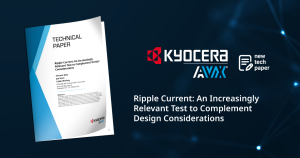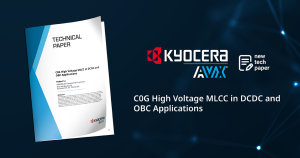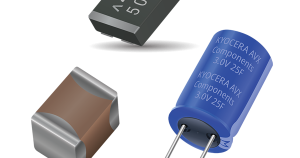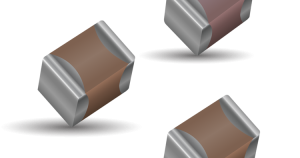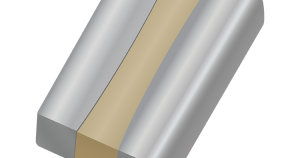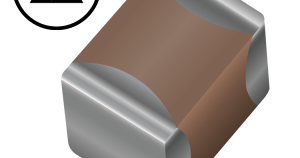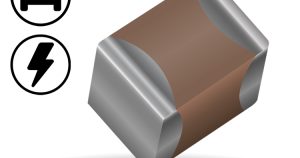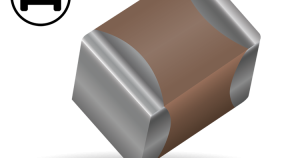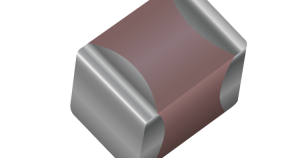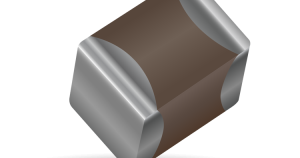Ripple Current: An Increasingly Relevant Test to Complement Design Considerations Written By: Vincent Mao, Joe Hock, Caleb Winfrey Abstract: The world is shifting towards electrification with electric vehicles (EVs), renewable energy, and smaller, more powerful, but efficient, system-on-chips (SOCs) as both signal and power integrity across different environments become a concern. The ripple current test is usually required to assess device performance up to 20°C above room temperature. This overview focuses on the test setups used to cover three ESR tiers (low, medium, high, respectively) for applications from signal integrity to microwave/RF. We present initial results and procedures to collect and analyze data as well as considerations for performance impacts with mounted parts. Ongoing challenges are also discussed.
Ceramic Capacitors
C0G High Voltage MLCC in DCDC and OBC Applications Written By: Robert Lu Abstract: This white paper discusses the advantages of C0G high voltage MLCCs when compared to film capacitors. Capacitance stability is a crucial element when choosing the right resonant capacitor for resonant circuits. Minimum variations with shifts in temperature, voltage, and frequency fluctuation are desirable. Although film capacitors provide a good option for certain applications, advances in MLCC technology have improved the performance of other capacitor dielectrics. In DC-DC/OBC applications, C0G High Voltage MLCCs can represent a more suitable option when compared to film capacitors, maintaining minimal capacitance variation with temperature and low dissipation factor at high frequencies.
Surface Mount Capacitors for DC-DC Converter Applications Written By: Naotaka Hata Abstract: Tantalum, polymer, ceramic, film, and aluminum capacitors each offer a different set of operating and performance characteristics. Choosing the proper capacitor when designing DC-DC converters requires a careful understanding of these differences. High voltage front-end connections to the power source typically rely on aluminum capacitors, while intermediate step-down voltages often look towards the tantalum and ceramic families to take advantage of volumetric efficiency. The final load decoupling and bypass capacitors are generally found in the ceramic and film families. Surface mount (SMD) capacitors can be constructed using several different technologies to achieve a range of voltage tolerance, bulk capacitance, and parasitic device characteristics. As shown in Figure 1,
DC Bias Characteristics of Ceramic Capacitors Written By: Simon Cen Abstract: Most electrical engineers are at least familiar with the different ratings of ceramic capacitors, such as C0G and X7R. In many applications, the meaning of these character codes is relatively unimportant as some other factor, like price or size, may be driving component selection. Designers must be wary, however, as choosing the wrong combination of capacitor dielectric and applied voltage can have critical performance implications for the associated circuit. For class two dielectrics, the change in bulk capacitance with DC bias can be substantial. Understanding why this happens and how to choose a proper ceramic capacitor can eliminate this common pitfall.
Low Inductance Capacitors for High-Speed Decoupling Written By: Robert Lu Abstract: Modern integrated circuits (IC’s) consume power at rapidly varying rates due to the density of circuits on-board and the extreme speed at which they can operate. Power supplies are required to respond to these changes in load current while maintaining a constant operating voltage. This task is becoming increasingly difficult as the complexity of power distribution networks grows and printed circuit board (PCB) design requires optimization for parasitic inductance and capacitance. Therefore, any power supply performance slack must be absorbed by the all-too-common decoupling capacitor. As shown in Figure 1, a decoupling capacitor is simply an additional parallel capacitance that provides a stable voltage and source of current when
Variability and Tolerance of Ceramic Capacitors Written By: Robert Lu Abstract: The multi-layer ceramic capacitor (MLCC) is one of the most common capacitor varieties found in electronic design. It offers a wide range of bulk capacitance and voltage tolerance in numerous form factors at relatively low cost. While these devices have become commonplace in the designers’ tool chest, they exhibit some often overlooked peculiarities. Of primary concern is the sensitivity of effective capacitance to several environmental factors, including temperature, applied bias voltage, and age. If these factors are unaccounted for, the risk of product failure becomes very real, especially in manufacturing variability and overall tolerance stack-up.
Electrostatic Protection Using Ceramic Capacitors Written By: Oliver Zimmermann | John McCarry Abstract: Any conductive interface between an electrical circuit and the outside world introduces the possibility of damage through electrostatic discharge (ESD). Accumulated static charge on a person, a cable, or any similar surface can readily dissipate its stored potential energy upon contact into sensitive components resulting in highly destructive currents. Ideally, varistors and TVS diodes only activate to protect the circuit when a high voltage is present and impart no parasitic effects during normal operation. For high-speed data lines, in particular, it is critical that the protection device introduce as little capacitance as possible (Electronic Design). TVS diodes and varistors are therefore specified not only by their voltage
Key Parameters for Designing Ceramic Capacitors in SMPS Circuits Written By: Kevin Cho Abstract: Capacitors are ubiquitous and indispensable components of electronic circuits used for a plethora of uses. For engineers looking to design multilayer ceramic capacitors (MLCCs) in switch-mode power supplies (SMPS) such as Buck and Boost converters, some essential parameters to be considered include the ripple current capability, ripple voltage, and power dissipation. Using the KYOCERA AVX SpiCalci10 model simulation tool for SMPS capacitors, this whitepaper will outline various MLCC characteristics, AC current capability, and other considerations for circuit design.
Replacing Aluminum Electrolytic Capacitors with Tantalum or Ceramic Capacitors Written By: Teddy Won Abstract: Like all capacitors, electrolytics (e-caps) are based on the principle of storing energy in an electric field using a voltage applied across a dielectric. This paper discusses the basic structure and characteristics of electrolytics and shows alternates for circuit use.
High Voltage Ceramic Capacitors for Electric Vehicles Written By: Jeff Lee Abstract: Electric vehicles (EVs) have accelerated the demand for high-performance, high-reliability capacitor technologies. The wide array of voltage, power, and size requirements of the various electrical subsystems in modern EVs necessitates careful capacitor selection by designers. As shown in the blue segments of figure 1, these subsystems include AC-DC conversion, DCDC conversion, power management, and battery monitoring, to name a few.
The Case for Ceramic Capacitors in Electric Vehicle DC-DC Converters Written By: John Lee | Simon Cen Abstract: The emergence and future ubiquity of electric vehicles have created one of the most demanding application spaces for capacitors across a wide variety of use cases. From AC charging circuits to high-speed analog sensors, electric vehicles span the gamut of design constraints while also requiring the highest reliability standards in the worst possible environments.
Conductive Epoxy Attachment of Capacitors Written By: Ron Demcko | Ashley Stanziola Abstract: Compared to the vast majority, capacitor attachment via conductive epoxy is not a common technique among end-user applications. A significant amount of growth in capacitor usage has occurred in solder attachment methods. Furthermore, many publications on attachment methods focus predominantly on optimizing the multiple methods of solder component attachment. Therefore, confusion exists on the requirements needed to ensure reliable long-term attachment when using conductive epoxy material systems. This paper serves as a general introduction to conductive adhesives. It aims to assist end-users in the conductive epoxy attachment of SMT (Surface Mount Technology) components.
The Pros and Cons of MLCC Downsizing Written By: Frank Hodgkinson | Maureen Strawhorne Abstract: As integrated circuits (ICs) continue to pack more functionality into smaller packages, the need for bulk off-chip capacitance remains. In resonant circuits, such as phase-lock-loops (PLLs) and switching regulators, precision class one ceramic capacitor may be required. Such capacitors must maintain a tight capacitance range over process, voltage, and temperature variation (PVT) for the host IC to meet its performance specifications. In contrast, class two ceramic capacitors are required for nearly every IC in the form of decoupling and bypass capacitance. They may also be found in amplifier circuits, simple filters, and linear regulators where their function is less dependent on tightly specified impedance requirements.
The Application of Capacitors in Power Supply Regulator Circuits Written By: Rick Liu Abstract: Advancements in electronic technology over the last decade have led to smarter consumer electronics. As devices become smarter, the components used to power them are shrinking, resulting in small, but incredibly powerful devices — ones small enough to fit inside a pocket or around a wrist. With these smaller, denser designs, it can be impossible to separate analog and digital domains in the layout, as best practices used to dictate years ago. Today, design engineers are compelled to use many capacitors in the power network to attenuate high-frequency digital noise. Circuits are designed to expect pure, clean power without noise that will impact analog circuits.
AVX MLCC Flexiterm™: Guarding Against Capacitor Crack Failures Written By: Mark Stewart Abstract: The huge popularity of MLCC capacitors in comparison with alternative technologies is primarily a result of their superb reliability record and low cost. However, in certain circumstances problems can occur due to cracking in the ceramic portion of the component. These failures result from mechanical damage caused after soldering to the PCB; normally a consequence of PCB mishandling or when the assembly is located in extreme environmental conditions. This article outlines the main benefits and features of AVX’s ‘FlexiTerm™,’ a soft termination system that minimizes these failures by relieving the mechanical stress applied to the ceramic.
MLCC & TANTALUMINTERCHANGEABILITY Tantalum chip and Hi CV MLCC have a large degree of overlap in available capacitance ratings in common footprints. As MLCC production increased, many applications converted from tantalum to MLCC for many filtering, bypass, and hold-up applications. With the increasing demands seen for low voltage digital applications, tantalum electrolytic technologies have become a first choice for MLCC substitution. KYOCERA AVX is a leading international manufacturer and supplier of a wide range of advanced electronic components, including: capacitors, inductors, filters, and circuit protection devices. The KYOCERA AVX tantalum electrolytic division has maintained a leadership position in automotive, industrial, medical, space, military, consumer electronics, communications, and transportation markets for nearly 50 years. Maximum Available Capacitance by Case Size (6.3V):
